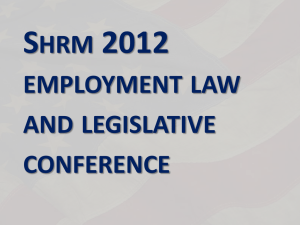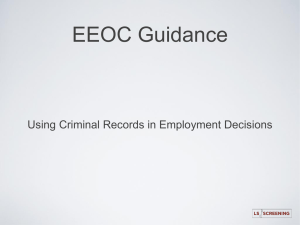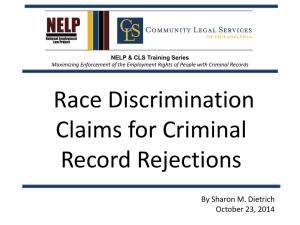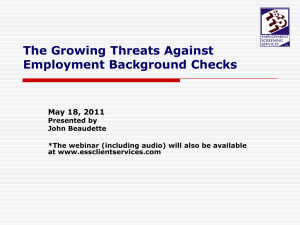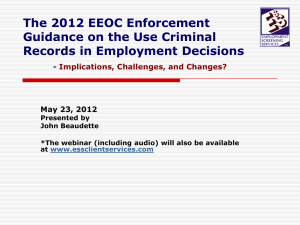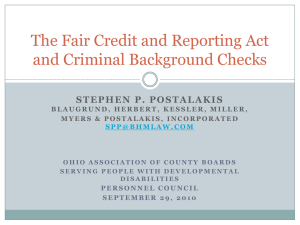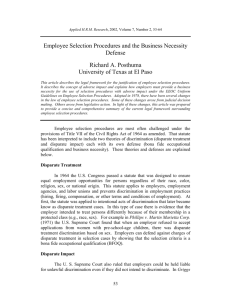Understanding the EEOC Guidance on Consideration of Arrest and
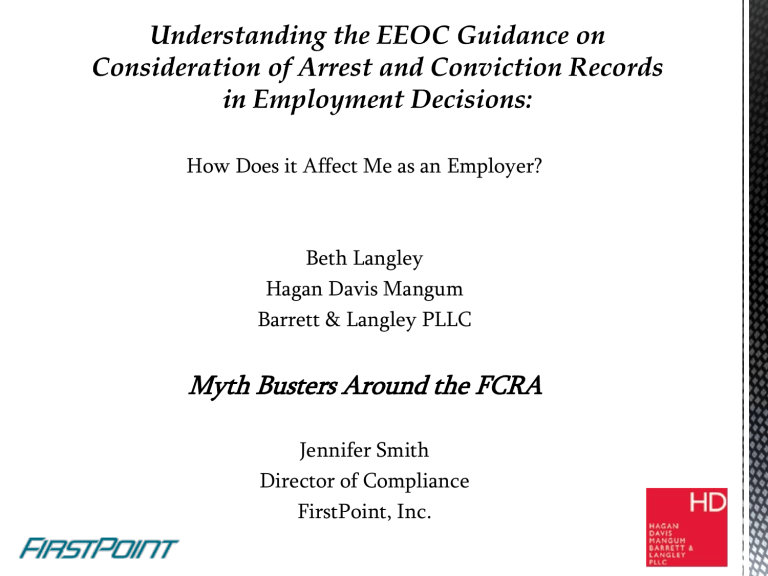
How Does it Affect Me as an Employer?
Beth Langley
Hagan Davis Mangum
Barrett & Langley PLLC
Myth Busters Around the FCRA
Jennifer Smith
Director of Compliance
FirstPoint, Inc.
Title VII of the Civil Rights Act of 1964, as amended
Fair Credit Reporting Act
Prior to April 25, 2012, the EEOC had generalized
Enforcement Guidance that
Discouraged employers from inquiring about arrests in employment decisions, due to the risk of disparate treatment
(adverse impact) on certain minorities; and
Encouraged employers to look at the circumstances underlying a record of a criminal conviction in relation to the employers’ job prior to making an adverse employment decision.
The Fair Credit Reporting Act requires:
Voluntary consent and detailed notices to all applicants/employees who are the subject of criminal background screenings through third party consumer reporting agencies (CRA’s).
CRA may not report records of arrests more than 7 years old.
The FCRA does not limit reporting of convictions. It does, however, provide an extensive mechanism for disputing inaccuracies in background screening and other consumer reports.
Disproportionately high incarceration rates of African
Americans and Hispanics, particularly men.
“Disparate Impact” discrimination of African Americans and Hispanics by Employers’ use of criminal background screening.
Disparate Treatment Discrimination
and
Disparate Impact Discrimination
Race, color, religion, sex and national origin.
An individual is treated differently in the terms and conditions of employment on the basis of race, color, religion, sex or national origin.
Example:
Employer rejected an African American candidate with a nonviolent misdemeanor offense that occurred more than 10 years ago, but has a history of hiring white candidates with comparable criminal records.
1991 Amendment to Title VII:
A particular employment practice that causes a disparate impact on the basis of race, color, religion, sex or national origin and the employer fails to demonstrate that the challenged practice is job related for the position in question and consistent with business necessity…” (emphasis added)
The bulk of the EEOC
Guidance addresses the EEOC’s concerns of Disparate Impact
Discrimination of
African-Americans and Hispanics as a result of criminal background screening.
What is a
“disparate impact?”
• Facially neutrally
• Has a disproportionately negative impact on a protected class
How is “Disproportionate Negative Impact” established?
How is “Disparate Negative Impact” established?
Employer’s inconsistent hiring/employment practices
Comparisons of similarly situated employees
Protected category vs. Non-protected category
Statistical Evidence
To avoid Title VII liability
If a facially neutrally policy has a disproportionate effect of screening out a Title VII protected group ( e.g.
, a particular race), the Employer has the burden of establishing that the employment policy/practice is job-related for the position in question and consistent with business necessity.
Per the EEOC Guidance:
In 2010, 28% of all arrests were of African Americans, even though African Americans comprised approximately 14% of the general population.
In 2008, Hispanics were arrested for federal drug charges at approximately 3 times the rate of the general population.
African Americans and Hispanics are incarcerated at rates disproportionate to their numbers in the general population.
Based upon the statistics cited by the EEOC in its
Guidance, the EEOC has concluded that criminal record exclusions have a disparate impact based on race and national origin, particularly as to African
Americans and Hispanics.
The proverbial
“Catch 22”.
EEOC Guidance does not affect liability for:
Negligent hiring/retention
Workplace violence
Homicide is the 4 th leading cause of death in the workplace
(U.S. Department of Labor, 2011)
Neither does the Guidance affect liability for:
Theft and fraud
Failure to comply with licensure requirements
Arrests:
An arrest should not be grounds for adverse action.
The facts underlying the arrest can be the basis for an adverse action.
Convictions:
“No Convictions/No Job” is no longer acceptable.
Inquire about criminal history when conditional offer is made, and not on job application.
Convictions:
Engage in a case-by-case analysis for each applicant/employee:
Nature and gravity of offense or conduct;
Time that has passed since the offense or conduct occurred /sentence was completed;
Nature of the job held or sought.
Provide applicant/employee an opportunity to explain circumstances.
Update Job Descriptions so it is apparent why background screening is job-related and consistent with business necessity.
Examples:
Handles money
Serves alcoholic beverages
Has access to sensitive financial information
Has access to patrons’ valuables
Examples, continued:
Works in close proximity to small children or to elderly
Security position
Inventory control position
Mobile workplace (e.g., shuttle drivers)
Examples, continued:
Works in stressful work environment
Delivers passengers, goods or services
Works in high crime area
Has access to medical supplies and pharmaceuticals
Examples, continued:
Works at night
Works alone
Document objective factors for employment decisionmaking
If background screening results are a factor in adverse decision, document why.
Review prior employment decisions for consistency.
Centralize employment decisions as much as possible to ensure consistency.
First, contrary to popular belief, there is no national computer or database of criminal records that contains all jurisdictions within the United States
Information Excluded from Consumer Reports
Suits and judgments which from the date of entry antedate the report by more than seven (7) years
Records of arrest or indictment which from the date of disposition, release or parole antedate the report by more than seven (7) years
Convictions, except in certain states , are reported indefinitely
Examples of states with reporting restrictions limit reporting of criminal convictions to 7 years:
California (Cal Civil Code § 1785.13
Nevada (NRS §598C.150)
New Mexico (N.M. Stat. Ann. §56-3-6)
Hawaii (HRS §378-2-§378-3) limits reporting to 10 years
Employers may not receive information on certain cases that have been…
Sealed
Pardon granted
Where the applicant received “diversion” which is a special procedure that does not count as a conviction
Certain States have more restrictive versions of the FCRA
For instance, Kentucky KRS Chapter 367.310 . No consumer reporting agency shall maintain any information in its files relating to any charge in a criminal case, in any court of this Commonwealth, unless the charge has resulted in a conviction.
In Hawaii, inquiry into and consideration of conviction records for prospective employees shall take place only after the prospective employee has received a conditional offer of employment which may be withdrawn if the prospective employee has a conviction record that bears a rational relationship to the duties and responsibilities of the position.
Massachusetts Employers may not, under any circumstances, inquire or maintain records related to a first conviction for any of the following misdemeanors: drunkenness, simple assault, speeding, minor traffic violations, affray, or disturbance of the peace.
Written Consent and Disclosure
Section 604(b)(2)(A) Disclosure to Consumer - a clear and conspicuous disclosure has been made in writing to the consumer at any time before the report is procured or caused to be procured, in a document that consists solely of the disclosure, that a consumer report may be obtained for employment purposes;
While the section reads “solely of the disclosure”, the document may also include:
A brief description of the nature of the consumer report
The consumer’s authorization for procurement of the report
However, it may NOT be included in the employment application
Effectiveness of Disclosure and Authorization
An employer may use a one-time evergreen disclosure, and obtain permission from applicants or current employees to procure consumer reports, at any time during the employee’s tenure. The disclosure must state “clearly and conspicuously “ that the employer intends for the disclosure and authorization to cover both the application for employment and for the duration of the employment.
Adverse Action Notices
Adverse action: a negative employment action such as not hiring an applicant; not retaining an employee or denying a promotion.
If an employer takes adverse action against an applicant or employee based in whole or in part on information contained in a consumer report or an investigative consumer report, the employer must provide a “pre-adverse action” notice under Section 604(b) before taking the adverse action and a subsequent “adverse action” notice under Section 615(a) after adverse action is taken.
Once the employer provides the pre-adverse action notice, including a copy of the background report as well as a statement of rights prepared by the Federal Trade Commission (FTC), the employer must wait a “reasonable period of time” before sending the second notice. Therefore, the notices may not be included in the same document.
The adverse action notice does not need to include the specific reason for the adverse action, but it must include:
Note that the adverse action is based either in whole or in part on information contained in the background report.
State the consumer reporting agency did not make the adverse employment decision and does not know the basis for the decision
Include the name, address and toll free number of the consumer reporting agency
Inform the applicant of his/her right to obtain another free copy of his/her consumer report within the next 60 days.
Recent Class Actions against Employers for Violations of the
Fair Credit Reporting Act
'Singleton, et. al. vs. Domino's Pizza' (United States District Court - Maryland) The lawsuit contends that the plaintiffs were terminated after background checks were completed, but were not provided with a copy of the report or advised of any rights before their termination. Furthermore, both plaintiffs alleged that the background screening consent they signed included a release of liability for the background check on the form that was part of the application packet.
If Domino’s is found to have willfully violated the FCRA, then the damage can be up to $1,000 a person regardless of actual damages
Note: Just because a lawsuit is filed and allegations are made by no means proves the validity of the plaintiff’s claims. However, this highlights the need for employers to review their background screening programs to ensure they are in compliance with the Fair Credit Reporting Act.
